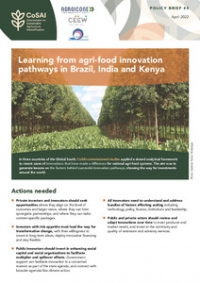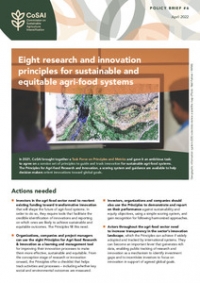This post is written in response to Water Funds: Priming the corporate pump? by Fred Pearce
What are we to make of the proliferation of water funds around the world? Now there’s a question.
Would they still be growing in number if they weren’t delivering tangible impacts?
If you take into account a recent paper by Bioversity International (Get the science right when paying for nature’s services), which found that 60 per cent of the 118 Payment for Ecosystem Services (PES) interventions they assessed lack fundamental scientific principles to support them, the answer in some cases may well be yes.
Which is why it is vital that they get the science right.
[Soil testing at the source of the Tana. Soil erosion washes valuable top soil where it affects communities downstream. Photo: Georgina Smith/CIAT] Water quality testing at the source of the Tana. Soil erosion washes valuable top soil where it affects communities downstream. Photo: Georgina Smith/CIAT
The principle behind water funds, similar to PES, is that it is cheaper to prevent water problems at the source than it is to address them further downstream. Water funds act to bridge the interests of the different stakeholders with the downstream urban beneficiaries for clean water and upstream rural stewards for land-conservation measures.
Science-based evidence
Without built-in accountability mechanisms for all relevant stakeholders that draw on science-based evidence, there can be no case for investment in upstream conservation measures in the first place, let alone evidence that they are delivering on their promises, such as cleaner water downstream, increased flows in the river and improved livelihoods upstream.
Science-based evidence generated through monitoring, evaluation and modeled assessments from the relevant data sources on the Water Fund is essential for building the confidence needed to gain new partnerships and policy commitments from governments, investors, development agencies, and the rural families whose livelihoods are at stake.
As a research partner on the newly launched Tana-Nairobi Water Fund, the International Center for Tropical Agriculture (CIAT) provides scientific accountability that will measure whether the conservation measures supported by the Fund are delivering more, cleaner and cheaper water to downstream water users, including 4 million people living in Nairobi over the coming years.
Read the report: Using an ecosystems approach for securing water and land resources in the Upper Tana Basin
But more importantly, CIAT will assess whether the interventions such as tree planting, terracing on very steep slopes, riparian buffer management and grass strips are indeed protecting the watershed and enabling communities living upstream to safeguard their land and their livelihoods. The goal is to determine if these upstream communities benefit from the projected US 3 million per year (as evidenced by the business-case) in improved yields that interventions backed by the fund will provide.
The business case
Achieving the goals of the new fund will be no mean feat. It starts with laying strong foundations. At just a few months old, the Fund is in its infancy. The business case has been made, and the Water Fund is close to achieving charitable status. The business case demonstrated that there is a clear economic basis for the establishment of the Water Fund by evaluating the impact of conservation interventions to reduce suspended sediment in waterways and increase dry season flows, two of the key issues affecting water supply and community sustainability.
The next step is to ensure all stakeholders are represented at the table, including farmers and county government representatives. Including people who are economically and socially marginalized is especially critical for achieving equitable sharing of both the benefits of land restoration, conservation funds as well as the responsibilities.
So where does the science come in?
CIAT’s role, which is funded by the CGIAR Research Program on Water Land and Ecosystems, is to monitor the on-going impact of the fund’s interventions on soil erosion and water quality. We are doing this by working with farmers and implementing partners on the ground.
Together with Kenya’s Water and Resource Management Authority, these activities will provide evidence on the effectiveness of interventions in retaining soil as well as changes in sedimentation levels in the river. We will also measure the impact of land use changes and different crops on different areas. By projecting scenarios in land-use changes, partners working on the ground can advise farmers on smart cropping interventions and possible alternatives for diversification so they can make crop choices that better protect soil from erosion and adapt to the changing climate.
Future research will also take into consideration climate change impacts on agriculture. Within the 30-year time frame of the business case, rainfall is expected to become more variable and heavier. Without good soil management soil loads in the river will only increase. Good soil management plays an essential role in maintaining the health of the whole ecosystem, including the provision of clean water downstream.
Green Rangers
While the Tana-Nairobi Water Fund currently targets farmers, research also shows that interventions also need target other contributors to sedimentation, such as quarries and unpaved roads. Hydrological modelling shows that quarries have a major impact on soil erosion and water quality. In one of the Tana watersheds, quarries account for one quarter of all sedimentation.
For that reason, the Water Fund has the flexibility to grow. The Nature Conservancy is already actively engaging quarrying communities to enable accountable stewardship. Through collaboration with implementing partners the Water Fund has formed the “Green Rangers” who ensure that mitigation measures are in place to avoid the impact that quarries can have.
The Tana-Nairobi Water Fund has a long way to go before it starts delivering the results promised in the business case – 10 to 30 years in fact. But if stakeholders within the watershed don’t come together and act now, in 30 years’ time the Tana River, on which so many millions of people rely for their water and livelihoods, will be in much greater jeopardy for farmers and businesses alike.
Read The Nature Conservancy's response here: From Trees to Taps.
Media: Joint TNC-CIAT Press Release
TNC Tana-Nairobi Water Fund: Business Case
Research: WLE Tana research report
Video: The ground beneath your feet
Photos: Kenya’s Tana River watershed
Stories: Costing the earth: who’s responsible? & Could climate change spell trouble for Kenya’s largest river














Comments
Water is very vital to us all despite tbe changes which have been brought about by human activities. we can conserve our water to remain clean and increase it in volume or maintain it in various ways. if you know about a watershed, this is the best way we can handle water related issues without misusing the funds because it involves alot of activities which can really change the water quality and quantity without affecting the environment.
please if you need more information contact me on my address atugonzamorris5@gmail.com
Thanks
Morris